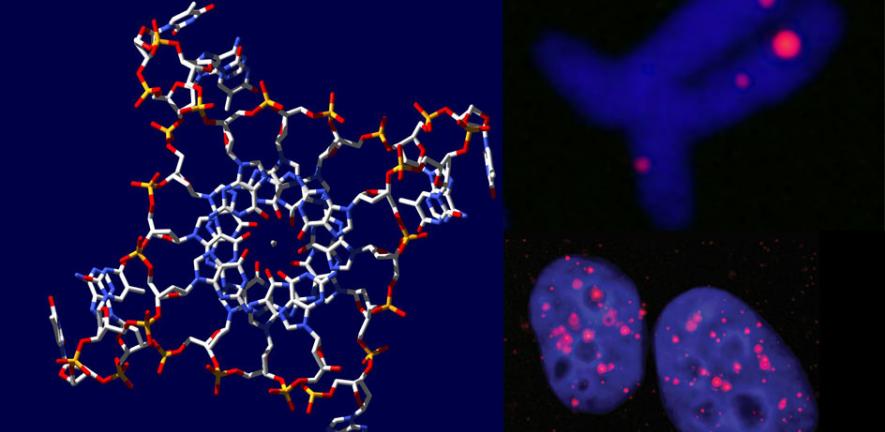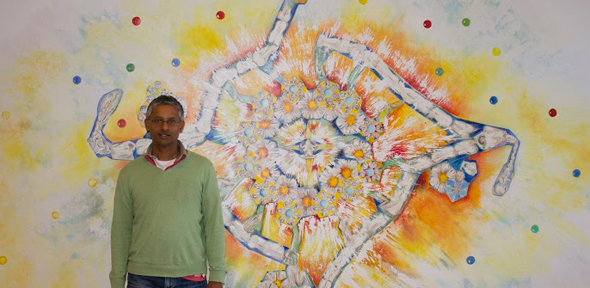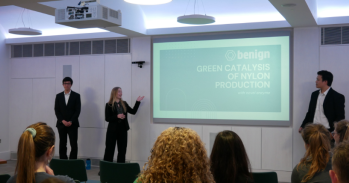
Discovery opens up possibilities for a new generation of targeted therapies for cancer.
Discovery opens up possibilities for a new generation of targeted therapies for cancer.
For us, it strongly supports a new paradigm to be investigated - using these four-stranded structures as targets for personalised treatments in the future.
Shankar Balasubramanian
In 1953, Cambridge researchers Watson and Crick published a paper describing the interweaving ‘double helix’ DNA structure – the chemical code for all life.
Now, in the year of that scientific landmark’s 60th Anniversary, Cambridge researchers have published a paper proving that four-stranded ‘quadruple helix’ DNA structures – known as G-quadruplexes – also exist within the human genome. They form in regions of DNA that are rich in the building block guanine, usually abbreviated to ‘G’.
The findings mark the culmination of over 10 years investigation by scientists to show these complex structures in vivo – in living human cells – working from the hypothetical, through computational modelling to synthetic lab experiments and finally the identification in human cancer cells using fluorescent biomarkers.
The research, published today in Nature Chemistry and funded by Cancer Research UK, goes on to show clear links between concentrations of four-stranded quadruplexes and the process of DNA replication, which is pivotal to cell division and production.
By targeting quadruplexes with synthetic molecules that trap and contain these DNA structures – preventing cells from replicating their DNA and consequently blocking cell division – scientists believe it may be possible to halt the runaway cell proliferation at the root of cancer.
“We are seeing links between trapping the quadruplexes with molecules and the ability to stop cells dividing, which is hugely exciting,” said Professor Shankar Balasubramanian from the University of Cambridge’s Department of Chemistry and Cambridge Research Institute, whose group produced the research.
“The research indicates that quadruplexes are more likely to occur in genes of cells that are rapidly dividing, such as cancer cells. For us, it strongly supports a new paradigm to be investigated – using these four-stranded structures as targets for personalised treatments in the future.”
Physical studies over the last couple of decades had shown that quadruplex DNA can form in vitro – in the ‘test tube’, but the structure was considered to be a curiosity rather than a feature found in nature. The researchers now know for the first time that they actually form in the DNA of human cells.
“This research further highlights the potential for exploiting these unusual DNA structures to beat cancer – the next part of this pipeline is to figure out how to target them in tumour cells,” said Dr Julie Sharp, senior science information manager at Cancer Research UK.
“It’s been sixty years since its structure was solved but work like this shows us that the story of DNA continues to twist and turn.”

Shankar Balasubramanian in front of a mural in his office representing quadruplex DNA, called ‘Living by the code’ by artist Annie Newman.
The study published today was led by Giulia Biffi, a researcher in Balasubramaninan’s lab at the Cambridge Research Institute.
By building on previous research, Biffi was able to generate antibody proteins that detect and bind to areas in a human genome rich in quadruplex-structured DNA, proving their existence in living human cells.
Using fluorescence to mark the antibodies, the researchers could then identify ‘hot spots’ for the occurrence of four-stranded DNA – both where in the genome and, critically, at what stage of cell division.
While quadruplex DNA is found fairly consistently throughout the genome of human cells and their division cycles, a marked increase was shown when the fluorescent staining grew more intense during the ‘s-phase’ – the point in a cell cycle where DNA replicates before the cell divides.
Cancers are usually driven by genes called oncogenes that have mutated to increase DNA replication – causing cell proliferation to spiral out of control, and leading to tumour growth.
The increased DNA replication rate in oncogenes leads to an intensity in the quadruplex structures. This means that potentially damaging cellular activity can be targeted with synthetic molecules or other forms of treatments.
“We have found that by trapping the quadruplex DNA with synthetic molecules we can sequester and stabilise them, providing important insights into how we might grind cell division to a halt,” said Balasubramanian.
“There is a lot we don’t know yet. One thought is that these quadruplex structures might be a bit of a nuisance during DNA replication – like knots or tangles that form.
“Did they evolve for a function? It’s a philosophical question as to whether they are there by design or not – but they exist and nature has to deal with them. Maybe by targeting them we are contributing to the disruption they cause.”
The study showed that if an inhibitor is used to block DNA replication, quadruplex levels go down – proving the idea that DNA is dynamic, with structures constantly being formed and unformed.
The researchers also previously found that an overactive gene with higher levels of quadruplex DNA is more vulnerable to external interference.
“The data supports the idea that certain cancer genes can be usefully interfered with by small molecules designed to bind specific DNA sequences,” said Balasubramanian.
“Many current cancer treatments attack DNA, but it’s not clear what the rules are. We don’t even know where in the genome some of them react – it can be a scattergun approach.
“The possibility that particular cancer cells harbouring genes with these motifs can now be targeted, and appear to be more vulnerable to interference than normal cells, is a thrilling prospect.
“The ‘quadruple helix’ DNA structure may well be the key to new ways of selectively inhibiting the proliferation of cancer cells. The confirmation of its existence in human cells is a real landmark.”
For more information on this story, please contact Fred Lewsey (fred.lewsey@admin.cam.ac.uk) at the University of Cambridge Office of External Affairs and Communications.
This work is licensed under a Creative Commons Licence. If you use this content on your site please link back to this page.





